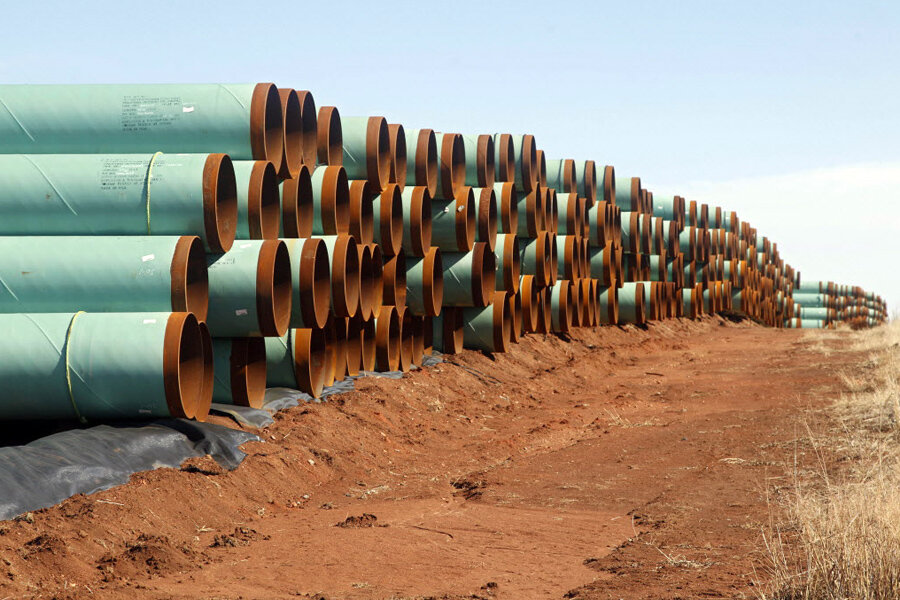As US delays Keystone XL, Albertans ask 'What's the holdup, eh?'
Loading...
| Calgary, Alberta
Oil was supposed to flow freely from the frozen north of this Canadian province, along with expectations that the US market could consume all of the crude that companies here produced. Much of it was to be moved by the Keystone XL pipeline, which would bring bitumen from the Alberta oil sands to refineries on the US Gulf Coast.
But the ongoing legal limbo of the pipeline – underscored yesterday by President Barack Obama, who said that Keystone XL should be approved only if it will not produce a net increase in greenhouse gas emissions – has created concern and uncertainty in the Canadian oil industry and the province of Alberta, where projects in the oil sands are being reevaluated and government royalty revenues have been reduced.
It’s also brought a sense of bewilderment for some Canadian politicians and pipeline proponents – especially those who speak openly of environmental concerns and posit that increased shipments of Alberta oil would simply displace imports from less-friendly places such as Venezuela and the Middle East.
Price handicap
Alberta is oil country, but these days its main export can sell at more than $30 per barrel below the West Texas Intermediate benchmark price – thanks to the heavy nature of Canadian oil, a glut of competing oil from North Dakota's Bakken rock formation, and a lack of pipeline capacity.
As a result, Alberta is feeling the pinch – both in terms of its private oil industry and in dented provincial government finances. Alison Redford, the premier of Alberta, blamed the price difference for a budget deficit and social spending cuts in the province – long a conservative bastion with the lowest taxes in Canada and a dependence on oil and gas royalties for roughly one-third of government revenues.
And the low prices may also be discouraging further investment in the region. “The logistical bottlenecks on prices may already have played a role” in energy companies Total and Suncor cancelling an $11.7 billion oil-sands upgrader plant – which turns bitumen into synthetic crude – the International Energy Agency said in a May report. The discount, the report adds, may have “triggered reviews of many other capital expenditure projects.”
All that is raising the stakes for the Keystone XL pipeline. “In the view of the province, [Keystone XL] is a must-go,” says Keith Brownsey, a political science professor at Mount Royal University, who points to the steady stream of federal and provincial officials making US lobbying trips as a sign of the angst the pipeline's delay is causing in Alberta.
Industry officials insist there’s no angst and reject claims that oil sands production makes Canada a petroleum pariah. The Canadian Association of Petroleum Producers (CAPP) says practices have improved, environmental regulations in Alberta are strict (unlike those in less-developed countries), and that the carbon footprint of oil sands petroleum has shrunk approximately 1 percent annually for 20 years. Companies in the oil sands also created a consortium to share environmental technologies.
Still, local leaders express amazement at the attention paid to a lone pipeline project – as opposed to other sources of greenhouse gas emissions.
“A lot of Albertans are a bit quizzical about why one pipeline has been made to bear the load of energy usage in the developed world,” Calgary Mayor Naheed Nenshi said last September.
Looking for solutions
In spite of the uncertainty, CAPP forecasts $63 billion in capital investments this year, with $23 billion destined for the oil sands – which it estimates will produce 5.2 million barrels per day by 2030, nearly triple today's output.
Companies also are considering alternatives for accessing markets. Rail-cars already carry 130,000 barrels of oil per day, and projects have been proposed to send petroleum to the west and east coasts of Canada, says Greg Stringham, CAPP’s vice-president markets and oil sands.
A pipeline to the West Coast has encountered opposition in British Columbia, but other options are being reviewed – such as Line 9, which would have its flow reversed to carry oil from Sarnia, Ontario, on the border with Michigan, to Montreal.
Keystone XL is still the preferred option, Mr. Stringham says, “but the industry is very creative in finding solutions.”





